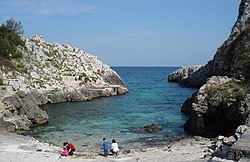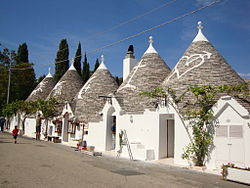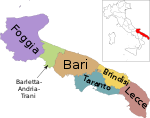Apulia: Difference between revisions
No edit summary Tags: Mobile edit Mobile web edit |
Cyberbot II (talk | contribs) Rescuing 3 sources, flagging 0 as dead, and archiving 0 sources. (Peachy 2.0 (alpha 8)) |
||
| Line 62: | Line 62: | ||
== Economy == |
== Economy == |
||
The region's contribution to Italy's [[gross value added]] was around 4.6% in 2000, while its population was 7% of the total. The per capita GDP is low compared to the national average and represents about 68.1% of the EU average.<ref>{{cite web|url=http://www.greenreport.it/contenuti/leggi.php?id_cont=11969 |title=Eurostat |publisher=Greenreport |date= |accessdate=2010-08-02 |
The region's contribution to Italy's [[gross value added]] was around 4.6% in 2000, while its population was 7% of the total. The per capita GDP is low compared to the national average and represents about 68.1% of the EU average.<ref>{{cite web|url=http://www.greenreport.it/contenuti/leggi.php?id_cont=11969 |title=Eurostat |publisher=Greenreport |date= |accessdate=2010-08-02 |deadurl=yes |archiveurl=https://web.archive.org/20140424084354/http://www.greenreport.it/contenuti/leggi.php?id_cont=11969 |archivedate=April 24, 2014 }}</ref> |
||
In comparison with the country as a whole, the economy of Apulia is characterised by a greater emphasis on agriculture and services and a smaller part played by industry. The share of gross value added generated by the agricultural and services sectors in the total gross value added of the region is above the national average in 2000, whereas the share of industry is below.<ref name="c.europa.eu">{{cite web|url=http://circa.europa.eu/irc/dsis/regportraits/info/data/en/itf4_eco.htm |title=Eurostat |publisher=c.europa.eu |date= |accessdate=2010-04-22 |
In comparison with the country as a whole, the economy of Apulia is characterised by a greater emphasis on agriculture and services and a smaller part played by industry. The share of gross value added generated by the agricultural and services sectors in the total gross value added of the region is above the national average in 2000, whereas the share of industry is below.<ref name="c.europa.eu">{{cite web|url=http://circa.europa.eu/irc/dsis/regportraits/info/data/en/itf4_eco.htm |title=Eurostat |publisher=c.europa.eu |date= |accessdate=2010-04-22 |deadurl=yes |archiveurl=https://web.archive.org/20090821143316/http://circa.europa.eu:80/irc/dsis/regportraits/info/data/en/itf4_eco.htm |archivedate=August 21, 2009 }}</ref> |
||
In the last 20 years the industrial base of the region's economy has changed radically. Alongside highly capital-intensive large-scale plants – such as [[Gruppo Riva|ILVA]] (steel-making) in [[Taranto]] and [[Eni]] (petrochemicals) in [[Brindisi]] and [[Manfredonia]] – a network of small and medium-sized firms has gradually expanded, and these now provide approximately 70% of the jobs in the region. |
In the last 20 years the industrial base of the region's economy has changed radically. Alongside highly capital-intensive large-scale plants – such as [[Gruppo Riva|ILVA]] (steel-making) in [[Taranto]] and [[Eni]] (petrochemicals) in [[Brindisi]] and [[Manfredonia]] – a network of small and medium-sized firms has gradually expanded, and these now provide approximately 70% of the jobs in the region. |
||
| Line 97: | Line 97: | ||
The population density in Apulia is just above the national average. In 2008 it was equal to 211 inhabitants per km². Foggia is by far the least densely populated province (96 inhabitants per km² in 2008), whereas Bari is the most densely populated province (308 inhabitants per km² in 2008). {{citation needed|date=October 2014}} |
The population density in Apulia is just above the national average. In 2008 it was equal to 211 inhabitants per km². Foggia is by far the least densely populated province (96 inhabitants per km² in 2008), whereas Bari is the most densely populated province (308 inhabitants per km² in 2008). {{citation needed|date=October 2014}} |
||
Emigration from the region's depressed areas to northern Italy and the rest of Europe was very intense in the years between 1956 and 1971. Subsequently the trend declined as economic conditions improved, to the point where there was net immigration in the years between 1982 and 1985. Since 1986 the stagnation in employment has led to a new inversion of the trend, caused by a decrease in immigration.<ref>{{cite web|url=http://circa.europa.eu/irc/dsis/regportraits/info/data/en/itf4_pop.htm |title=Eurostat |publisher=c.europa.eu |date= |accessdate=2010-04-22 |
Emigration from the region's depressed areas to northern Italy and the rest of Europe was very intense in the years between 1956 and 1971. Subsequently the trend declined as economic conditions improved, to the point where there was net immigration in the years between 1982 and 1985. Since 1986 the stagnation in employment has led to a new inversion of the trend, caused by a decrease in immigration.<ref>{{cite web|url=http://circa.europa.eu/irc/dsis/regportraits/info/data/en/itf4_pop.htm |title=Eurostat |publisher=c.europa.eu |date= |accessdate=2010-04-22 |deadurl=yes |archiveurl=https://web.archive.org/20110721132805/http://circa.europa.eu/irc/dsis/regportraits/info/data/en/itf4_pop.htm |archivedate=July 21, 2011 }}</ref> |
||
== Government and politics == |
== Government and politics == |
||
Revision as of 05:13, 28 August 2015
41°0′31″N 16°30′46″E / 41.00861°N 16.51278°E Template:Infobox Region of Italy
Apulia (/əˈpuːliə/ ə-POO-lee-ə; Italian: Puglia)[note 1] is a region of Italy in Southern Italy bordering the Adriatic Sea in the east, the Ionian Sea to the southeast, and the Strait of Òtranto and Gulf of Taranto in the south. Its southernmost portion, known as Salento peninsula, forms a high heel on the "boot" of Italy. The region comprises 19,345 square kilometers (7,469 sq mi), and its population is about 4.1 million. It is bordered by the other Italian regions of Molise to the north, Campania to the west, and Basilicata to the southwest. It neighbors Albania, Bosnia-Herzegovina, Croatia, Greece, and Montenegro, across the Adriatic and Ionian Seas. The region extends as far north as Monte Gargano. Its capital city is Bari.
Geography

Situated at the south-eastern tip of the Italian peninsula, Apulia covers over 19,000 square kilometers (7,336 sq mi) in succession of broad plains and low-lying hills. The central area of the region is occupied by the Murge, a vast karst plateau and Itria Valley. The only mountainous areas, the Gargano promontory and the Monti Dauni, do not exceed 1,150 m (3,800 ft) and are to be found in the north of Apulia, which is the least mountainous region in Italy. 32 Kilometers north east of the town Peschici is the Croatian Island of Palagruža. [citation needed]
History




Apulia is one of the richest archaeological regions in Italy. It was first colonized by Mycenaean Greeks.[1] At the 8th century BC, the Ancient Greeks expanded until reaching the area of Taranto and Salento in Magna Graecia. In the 5th and 4th centuries BC, the Greek settlement at Taras produced a distinctive style of pottery (Apulian vase painting). [citation needed]
Apulia was an important area for the ancient Romans, who conquered it during the course of wars against the Samnites and against Pyrrhus in the 4th and 3rd centuries BC but also suffered a crushing defeat here in the battle of Cannae against Hannibal. However, after the Carthaginians left the region, the Romans captured the ports of Brindisi and Taranto, and established dominion over the region. During the Imperial age Apulia was a flourishing area for production of grain and oil, becoming the most important exporter to the Eastern provinces.[citation needed]
Robert Guiscard set up the Duchy of Apulia in 1059. After the Norman conquest of Sicily in the late 11th century, Palermo replaced Melfi (just west of present day Apulia) as the center of Norman power.[citation needed]
From the late 12th to early 13th centuries, it was a favorite residence of the Hohenstaufen emperors, notably Frederick II.[citation needed] A number of castles were built in the area by Frederick, including Castel del Monte.[2]
After 1282, when the island of Sicily was lost, Apulia was part of the Kingdom of Naples (confusingly known also as the Kingdom of Sicily), and remained so until the unification of Italy in the 1860s. This kingdom was independent under the House of Anjou from 1282 to 1442, then was in union to with Aragon until 1458, after which it was again independent under a cadet branch of the House of Trastámara until 1501. As a result of the French-Spanish war of 1501-1504, Naples again came under the rule of Aragon and the Spanish Empire from 1504 to 1714. When Barbary pirates of North Africa sacked Vieste in 1554, they took an estimated 7,000 slaves, and the coast of Apulia was occupied at times by the Turks and by the Venetians.
With the rest of the Kingdom of Naples, Apulia was part of the Austrian Empire from 1714 until 1735. The Battle of Bitonto of 1734 was a Spanish victory over the Austrian forces, and Apulia was held by a branch of the Spanish Bourbons from 1735 to 1806, when Naples became a client state of Napoleon's French Empire until his final overthrow in 1815. The effective French control of the region resulted in the abolition of feudalism and the reform of the system of justice.[citation needed]
In 1861 the region became part of the Kingdom of Italy.[3]
Economy
The region's contribution to Italy's gross value added was around 4.6% in 2000, while its population was 7% of the total. The per capita GDP is low compared to the national average and represents about 68.1% of the EU average.[4]
In comparison with the country as a whole, the economy of Apulia is characterised by a greater emphasis on agriculture and services and a smaller part played by industry. The share of gross value added generated by the agricultural and services sectors in the total gross value added of the region is above the national average in 2000, whereas the share of industry is below.[5]
In the last 20 years the industrial base of the region's economy has changed radically. Alongside highly capital-intensive large-scale plants – such as ILVA (steel-making) in Taranto and Eni (petrochemicals) in Brindisi and Manfredonia – a network of small and medium-sized firms has gradually expanded, and these now provide approximately 70% of the jobs in the region.
The majority of such firms are financed by local capital. As a result, highly specialised areas have developed, producing on a scale not only of domestic but also of international significance: food processing and vehicles in the province of Foggia; footwear, textiles, wood and furniture in the Barletta area north of Bari; wood and furniture in the Murge area to the west; engineering, rubber, wood and furniture and computer software around Bari itself; textiles and clothing at Monopoli-Putignano to the south; and footwear and textiles in the Casarano area. In certain of these sectors – especially textiles, clothing, footwear, vehicles and food products – the region has attained a significant degree of competitiveness with foreign producers. A major contribution to the competitiveness of the region's economy stems from the existence of important research and development centres such as Tecnopolis-CSATA near Bari, the Cittadella della ricerca (Centre for research and new materials) near Brindisi and the new software development centres, again near Bari.[5]
The region has a good network of roads but the railway network is somewhat inadequate, particularly in the south. Apulia's 800 kilometers (497 mi) of coastline is studded with ports, which make this region an important terminal for transport and tourism to Greece and the eastern Mediterranean.[5]
In 2011 the economy expanded, to a greater extent than the rest of southern Italy.[6]
Demographics
| Year | Pop. | ±% |
|---|---|---|
| 1861 | 1,335,000 | — |
| 1871 | 1,440,000 | +7.9% |
| 1881 | 1,609,000 | +11.7% |
| 1901 | 1,987,000 | +23.5% |
| 1911 | 2,195,000 | +10.5% |
| 1921 | 2,365,000 | +7.7% |
| 1931 | 2,508,000 | +6.0% |
| 1936 | 2,642,000 | +5.3% |
| 1951 | 3,220,000 | +21.9% |
| 1961 | 3,421,000 | +6.2% |
| 1971 | 3,583,000 | +4.7% |
| 1981 | 3,872,000 | +8.1% |
| 1991 | 4,032,000 | +4.1% |
| 2001 | 4,021,000 | −0.3% |
| 2011 | 4,091,000 | +1.7% |
| Source: ISTAT 2001 | ||
The population density in Apulia is just above the national average. In 2008 it was equal to 211 inhabitants per km². Foggia is by far the least densely populated province (96 inhabitants per km² in 2008), whereas Bari is the most densely populated province (308 inhabitants per km² in 2008). [citation needed]
Emigration from the region's depressed areas to northern Italy and the rest of Europe was very intense in the years between 1956 and 1971. Subsequently the trend declined as economic conditions improved, to the point where there was net immigration in the years between 1982 and 1985. Since 1986 the stagnation in employment has led to a new inversion of the trend, caused by a decrease in immigration.[7]
Government and politics
At the April 2006 elections, Apulia gave about 51.54% of its votes to Silvio Berlusconi, and at the April 2008 election Apulians gave about 47% of their votes to the People of Freedom-led coalition, eleven points more than to the Democratic Party-led coalition. [citation needed]
Despite this, locally the region has been governed by a Left-wing coalition led by the Democratic Party and the Left Ecology Freedom party since 2005. Nichi Vendola of the Refoundation Communist Party was elected president, becoming the first openly gay president of an Italian region. Vendola was re-elected at the 2010 elections this time representing the Left Ecology freedom party. [citation needed]
Administrative divisions
Apulia is divided into six provinces (official data for the 6th province (Barletta-Andria-Trani), instituted in 2009, has only recently become available after the 2011 census):

| Province | Area (km²) | Population | Density (inh./km²) |
|---|---|---|---|
| Province of Bari | 3,821 | 1,256,821 | 328,9 |
| Province of Barletta-Andria-Trani | 1,543 | 392,237 | 254,2 |
| Province of Brindisi | 1,839 | 402,973 | 219.1 |
| Province of Foggia | 6,960 | 641,000 | 92.0 |
| Province of Lecce | 2,759 | 812,690 | 294.5 |
| Province of Taranto | 2,437 | 580,497 | 238.2 |
Culture
Cuisine
Cuisine plays an important role throughout Apulia, and the key locally produced ingredients used there include olive oil, artichokes, tomatoes, and mushrooms.[8]
Language
As with the other regions of Italy, the national language (since 1861) is Italian. However, as a consequence of its long and varied history, other historical languages have been spoken in this region for centuries. In the northern and central sections, some dialects of the Neapolitan language are spoken: for example Bari dialect, spoken in the zone of Bari or Foggiano near Foggia. In the southern part of the region, the Tarantino and Salentino dialects of Sicilian are spoken. The language has observed to have similarities to that of the Calabrian dialect, west of Apulia.
In isolated pockets of the Southern part of Salento, a dialect of modern Greek called Griko,[9] is spoken by just a few thousand people. A rare dialect of the Franco-Provençal language called Faetar is spoken in two isolated towns, Faeto and Celle Di San Vito, in the Province of Foggia. In a couple of villages, the Arbëreshë[10] dialect of the Albanian language has been spoken by a very small community since a wave of refugees settled there in the 15th century.

See also
Notes
- ^ From Greek Ἀπουλία; in Italian: Puglia pronounced [ˈpuʎʎa] (Demonym: Pugliese [puʎˈʎeːse]).
References
- ^ Elizabeth A. Fisher, The Mycenaeans and Apulia. An Examination of Aegean Bronze Age Contacts with Apulia in Eastern Magna Grecia, Astrom, 1998
- ^ "Italy: Puglia". Rough Guides. Retrieved 8 December 2013.
- ^ "Puglia". Merriam-Webster. Retrieved 8 September 2013.
- ^ "Eurostat". Greenreport. Archived from the original on April 24, 2014. Retrieved 2010-08-02.
{{cite web}}: Unknown parameter|deadurl=ignored (|url-status=suggested) (help) - ^ a b c "Eurostat". c.europa.eu. Archived from the original on August 21, 2009. Retrieved 2010-04-22.
{{cite web}}: Unknown parameter|deadurl=ignored (|url-status=suggested) (help) - ^ "NO. 18 - ECONOMIC DEVELOPMENTS IN PUGLIA". Regional Economies: Analysis by Region. Banca D'Italia. June 2012. Retrieved 8 September 2013.
- ^ "Eurostat". c.europa.eu. Archived from the original on July 21, 2011. Retrieved 2010-04-22.
{{cite web}}: Unknown parameter|deadurl=ignored (|url-status=suggested) (help) - ^ "Introducing Puglia". Lonely Planet. Retrieved 8 June 2014.
- ^ "Ethnologue report for language code:ell". Ethnologue.com. Archived from the original on 28 May 2010. Retrieved 2010-04-22.
{{cite web}}: Unknown parameter|deadurl=ignored (|url-status=suggested) (help) - ^ "Ethnologue report for language code:aae". Ethnologue.com. Retrieved 2010-04-22.
External links
- Official website Template:It icon
- Accademia Apulia (in Italian)
- Environmental League Puglia (in Italian)

